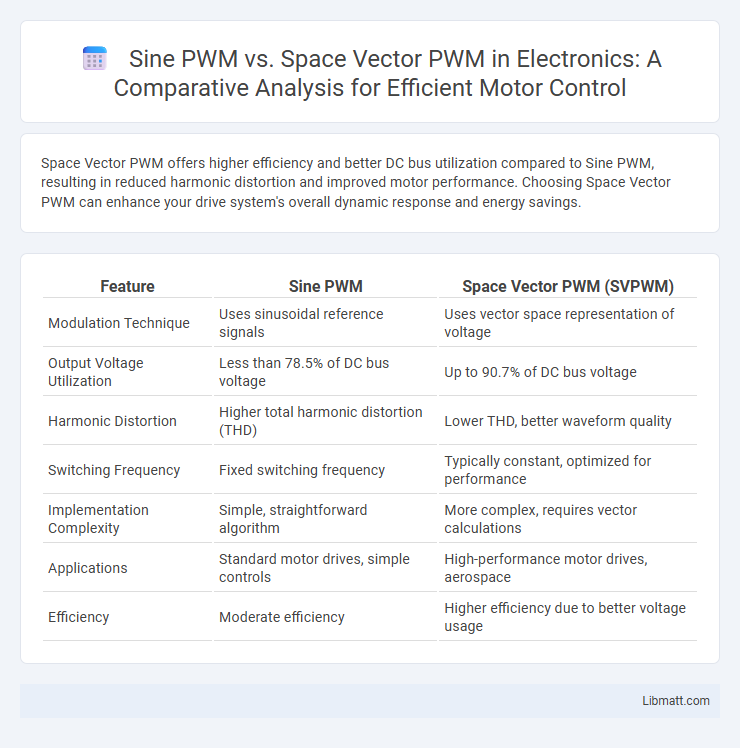Space Vector PWM offers higher efficiency and better DC bus utilization compared to Sine PWM, resulting in reduced harmonic distortion and improved motor performance. Choosing Space Vector PWM can enhance your drive system's overall dynamic response and energy savings.
Table of Comparison
| Feature | Sine PWM | Space Vector PWM (SVPWM) |
|---|---|---|
| Modulation Technique | Uses sinusoidal reference signals | Uses vector space representation of voltage |
| Output Voltage Utilization | Less than 78.5% of DC bus voltage | Up to 90.7% of DC bus voltage |
| Harmonic Distortion | Higher total harmonic distortion (THD) | Lower THD, better waveform quality |
| Switching Frequency | Fixed switching frequency | Typically constant, optimized for performance |
| Implementation Complexity | Simple, straightforward algorithm | More complex, requires vector calculations |
| Applications | Standard motor drives, simple controls | High-performance motor drives, aerospace |
| Efficiency | Moderate efficiency | Higher efficiency due to better voltage usage |
Introduction to PWM Techniques
Sine PWM and Space Vector PWM are advanced modulation techniques used in motor control to generate precise voltage waveforms. Sine PWM modulates the inverter's output by approximating sinusoidal waveforms, optimizing harmonic performance for smooth motor operation. Space Vector PWM enhances efficiency by utilizing vector space analysis to maximize DC bus voltage usage and reduce switching losses, providing superior control for Your motor drives.
Understanding Sine PWM
Sine PWM generates pulse width modulation signals by comparing a sinusoidal reference waveform with a high-frequency triangular carrier, producing a smooth output waveform ideal for AC motor control. This technique achieves lower harmonic distortion and simpler implementation compared to more complex methods. Understanding Sine PWM involves recognizing its reliance on sinusoidal modulation indices and carrier frequency to control inverter switching and optimize motor efficiency.
What is Space Vector PWM?
Space Vector PWM (SVPWM) is an advanced technique used in motor control to generate efficient pulse width modulated signals by representing three-phase voltages as a rotating vector in a two-dimensional plane. This method optimizes the inverter switching patterns to produce higher output voltage and reduce harmonic distortion compared to conventional sine PWM. SVPWM enhances motor performance by maximizing DC bus utilization and improving overall system efficiency.
Key Differences Between Sine PWM and SVPWM
Sine PWM generates pulse widths based on a sinusoidal reference signal for each phase, while Space Vector PWM (SVPWM) uses a vector approach to synthesize the desired voltage vector within the inverter's hexagonal voltage space. SVPWM offers higher DC bus utilization, resulting in better voltage output and reduced harmonic distortion compared to Sine PWM. Sine PWM is simpler and easier to implement, whereas SVPWM provides improved efficiency and performance in three-phase inverter control systems.
Modulation Principle Comparison
Sine PWM generates pulse widths by comparing a reference sine wave with a carrier triangular wave, resulting in a simple modulation scheme ideal for basic motor control. Space Vector PWM (SVPWM) uses a space vector approach to synthesize reference vectors within a hexagonal voltage space, enabling higher DC bus utilization and lower harmonic distortion. Your choice between these methods depends on whether you prioritize implementation simplicity with Sine PWM or improved voltage output and efficiency with SVPWM.
Efficiency and Harmonic Performance
Sine PWM generates switching signals based on sinusoidal references, leading to simpler implementation but higher harmonic distortion, which reduces efficiency in high-performance applications. Space Vector PWM (SVPWM) optimizes switching states by representing voltage vectors in a two-dimensional plane, resulting in lower total harmonic distortion (THD) and improved inverter efficiency. SVPWM provides better utilization of the DC bus voltage and smoother output waveforms, enhancing overall system performance compared to conventional sine PWM techniques.
Implementation Complexity
Sine PWM features a straightforward implementation process, relying on basic trigonometric computations to generate symmetrical waveforms suitable for simpler control systems. Space Vector PWM involves more complex algorithms that map voltage vectors in a two-dimensional plane, requiring higher computational power and precise timing for optimal performance. Your choice between the two should consider the system's processing capabilities and the need for advanced control precision.
Applications of Sine PWM and SVPWM
Sine PWM is widely used in low-power motor drives and applications requiring simple implementation and reduced harmonic distortion, such as household appliances and small industrial fans. Space Vector PWM excels in high-power inverter systems, including electric vehicle traction drives and renewable energy converters, due to its ability to optimize voltage utilization and improve efficiency. Your choice between Sine PWM and SVPWM depends on the specific performance and power requirements of your application.
Advantages and Disadvantages
Sine PWM offers simplicity in implementation and produces lower harmonic distortion in output voltage, making it suitable for applications requiring smooth sinusoidal waveforms. Space Vector PWM provides higher DC bus utilization and better torque response in motor drives but involves more complex calculations and switching sequences. Sine PWM's disadvantage is less efficient DC bus usage, while Space Vector PWM's complexity can increase controller cost and development time.
Summary: Choosing the Right PWM Technique
Sine PWM offers simplicity and ease of implementation, making it ideal for applications with moderate performance requirements and lower computational resources. Space Vector PWM provides higher efficiency and better harmonic performance, suited for advanced motor control and applications demanding precise modulation. Your choice depends on balancing complexity, performance needs, and hardware capability to optimize overall drive system efficiency.
Sine PWM vs Space Vector PWM Infographic

 libmatt.com
libmatt.com